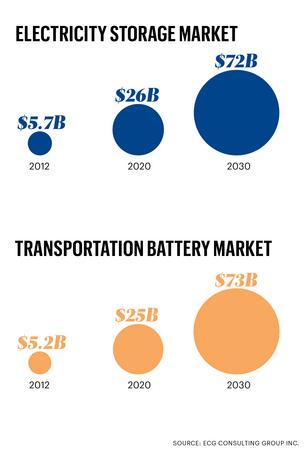Energy Storage North America (ESNA), the most influential gathering of policy, technology and market leaders in energy storage, concluded its second annual conference and expo with more than twice the previous year's attendance, a sold-out show floor, and praise from attendees for the high quality of programming, exhibits, and deal-supporting networking opportunities.
ESNA 2014 was held at the San Jose Convention Center in California from September 30th to October 2nd. Jointly organized by Messe Dusseldorf North America and Strategen Consulting, ESNA 2014 maintained its singular focus on projects, policies, applications, and deals. A total of 1,524 attendees (including 150 exhibitor personnel) from 26 countries, representing more than 500 organizations – including 100+ utility executives – celebrated successful commercial projects and revenue-generating applications, shared best practices and accelerated energy storage market development. Fifty exhibitors showcased innovative technologies that are transforming North America's grid infrastructure.
Some of the highlights included:
Over 100 speakers and 40+ conference sessions
The 2nd annual ESNA Innovation Awards for excellence in energy storage project development
The inaugural ESNA Champion Awards honoring leadership on the policy and utility side
Seven in-depth workshops and four half-day site tours of local storage installations
A private deal room for business transactions and discussions
Free Tesla Model S test drives for conference delegates
"ESNA has once again proven itself to be the go-to event for knowledge gathering and networking, as well as a productive ecosystem for deal-making in the energy storage market," said Tom Mitchell, President of Messe Dusseldorf North America. "This event's year-over-year growth, as well as the high number of senior-level attendees we're seeing, is a genuine reflection of the surging global interest in energy storage. For 2015, we plan to continue expanding and enhancing our attendee experience to keep pace with this dynamic industry."
"This year's ESNA exceeded our expectations in every aspect, especially the strong support we received from sponsors, attendees, exhibitors and speakers," said Janice Lin, Managing Partner of Strategen Consulting and Conference Chair of ESNA 2014. "With accelerating commercial progress in energy storage, both here in North America and around the world, it's gratifying to provide such a unique venue for sharing content and ideas within our industry."
ESNA is grateful to its 2014 supporters, including Platinum sponsors AES Energy Storage, Dynapower, GE Power & Water Energy Storage, NextEra Energy Resources, and Stem. Gold sponsors are: Coda Energy, East Penn, Energy Power Systems, FIAMM, K&L Gates, and Sunverge. Silver sponsors are: ADA-ES, Inc., Bosch, DC Systems, EDF Renewable Energy, Germany Trade & Invest, Green Charge Networks, Ingeteam, PG&E, Parker, S&C Electric, San Diego Gas & Electric, Sharp, Southern California Edison, Stoel Rives, Stornetic, Sumitomo Electric, UniEnergy Technologies, Wells Fargo. The ESNA 2014 Lunch Sponsor was NEC Energy Solutions.
For further information about Energy Storage North America, contact Messe Dusseldorf North America, 150 North Michigan Avenue, Suite 2920, Chicago, IL 60601. Telephone (312) 781-5180 or e-mail
[email protected].
Visit our website at
www.esnaexpo.com Subscribe to our blog at
www.esnaexpo.com/blog Follow us on Twitter at
www.twitter.com/energystoragena


